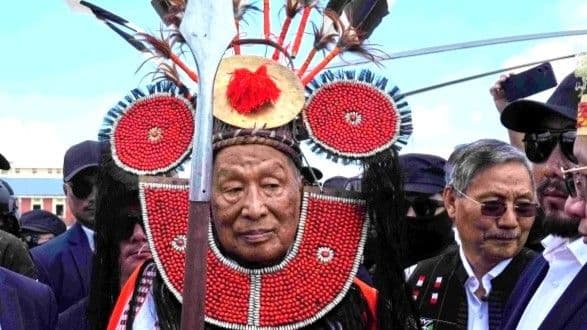We're loading the full news article for you. This includes the article content, images, author information, and related articles.
The homecoming of Thuingaleng Muivah, 91, leader of one of Asia's longest insurgencies, signals a pivotal moment for the stalled Naga peace process in India, reigniting debates on sovereignty and regional stability.

SOMDAL, MANIPUR – In a moment laden with historical significance, Thuingaleng Muivah, the 91-year-old general secretary of the National Socialist Council of Nagalim (Isak-Muivah) or NSCN (I-M), returned to his native village of Somdal in India's northeastern state of Manipur on Wednesday, October 22, 2025 (EAT), after more than 60 years. His arrival by helicopter was met by thousands of supporters, rekindling hope and debate surrounding one of the longest-running separatist movements in Asia.
For decades, Muivah has been a central figure in the Naga struggle for an independent homeland, a cause that has defined the political landscape of Northeast India since the country gained independence in 1947. His supporters view him as the steadfast guardian of the Naga aspiration for a sovereign state, often referred to as 'Nagalim' or "Greater Nagaland," which would unite Naga-inhabited territories across several Indian states and parts of neighboring Myanmar. However, his legacy is complex; critics and rival groups accuse the NSCN (I-M) of engaging in targeted killings, extortion through a parallel tax system, and fostering ethnic divisions—allegations the organization has consistently denied.
The roots of the Naga insurgency predate India's independence. In 1946, the Naga National Council (NNC) was formed to advocate for the political rights of the Naga people. On August 14, 1947, a day before India's independence, the NNC, under the leadership of Angami Zapu Phizo, declared Nagaland an independent state. This declaration was not recognized by the Indian government, leading to a protracted and often violent conflict.
Muivah, a member of the Tangkhul Naga tribe, joined the movement in 1964. A key turning point came in 1975 with the signing of the Shillong Accord, which a faction of the NNC agreed to, effectively accepting the Indian constitution. Muivah, along with Isak Chishi Swu and S.S. Khaplang, vehemently rejected the accord as a betrayal. In 1980, they broke away to form the National Socialist Council of Nagaland (NSCN). Internal disagreements later led to a split in 1988, with Muivah and Swu leading the NSCN (I-M) faction.
In August 1997, the NSCN (I-M) entered into a ceasefire agreement with the Indian government, paving the way for decades of negotiations. A significant milestone was the signing of a Framework Agreement on August 3, 2015, in the presence of Indian Prime Minister Narendra Modi. The agreement acknowledged the "unique history, culture and position of the Nagas." However, the peace process has since stalled. Key sticking points remain the NSCN (I-M)'s demands for a separate Naga flag and constitution (Yehzabo), which the Indian government has stated are outside the purview of the Indian Constitution. During his homecoming speech, read by a deputy, Muivah reiterated that these demands were non-negotiable and accused the Indian government of betraying the spirit of the 2015 agreement.
Muivah's return to Somdal—his first successful attempt after a 2010 bid was blocked by the Manipur government, leading to deadly protests—is seen by many as a symbolic gesture that could either break the current impasse or harden positions. His visit was permitted by the state government, which is currently under President's Rule, indicating a potential shift in the official approach to the issue.
The Naga insurgency is one of numerous ethnic and separatist conflicts that have characterized post-colonial nation-building across the globe. While there are no direct ties to Kenyan or East African political dynamics, the struggle for self-determination, the complexities of negotiating with armed groups, and the challenge of reconciling state sovereignty with ethnic identity are themes that resonate globally. The Naga quest for a unified territory across international borders mirrors similar ethno-nationalist aspirations in other parts of the world.
The resolution of the Naga issue holds significant implications for the stability of India's northeastern region, a strategic area bordering Myanmar and Bangladesh. A lasting peace could unlock economic potential and foster greater regional cooperation. Conversely, a breakdown in talks could reignite conflict, further destabilizing a region already grappling with multiple insurgencies and ethnic tensions. Muivah's return, at this critical juncture, places the future of the Naga political question firmly back in the spotlight, with its outcome poised to shape the geopolitical landscape of the region for years to come.
Keep the conversation in one place—threads here stay linked to the story and in the forums.
Other hot threads
E-sports and Gaming Community in Kenya
Active 6 months ago
Popular Recreational Activities Across Counties
Active 6 months ago
The Role of Technology in Modern Agriculture (AgriTech)
Active 6 months ago
Investing in Youth Sports Development Programs
Active 6 months ago